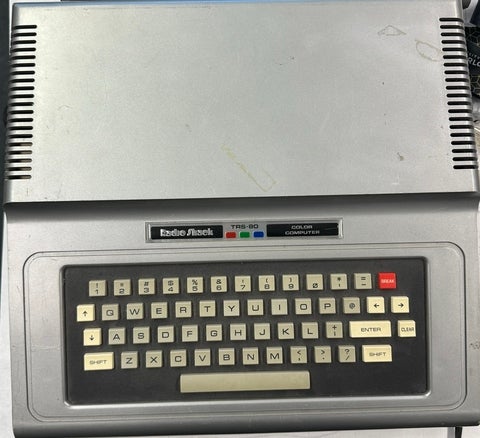Featured items in DC1316 - the Computer Museum office
We have a number of interactive and non-interactive items on display in DC1316. Come on in to check them out!
Interactive items
These are items that you can actually touch and interact with. We are trying to get more items working and available to use.
IBM Selectric III Typewriter

The IBM Selectric III typewriter
Try your hand at typing using this electric typewriter featuring a type ball and whiteout!
Commodore 64

Commodore 64
Create a program in BASIC, play a game of Frogger.
Commodore 64 Mini computer

Commodore 64 Mini computer
The Commodore 64 Mini is a modern recreation of the popular Commodore 64 computer, with many of the most popular C64 games built in! We've attached a joystick so that you can enjoy a variety of old favourites!
Apple II plus

Apple II plus
Create a BASIC program or run one of the many Apple ][ programs we have available.
IBM Personal Computer

IBM Personal Computer
The only thing BASIC about the IBM Personal Computer is its programming language.
TRS-80 Colour Computer

Radio Shack TRS-80 Colour Computer
Connect the CoCo to a TV and off you go!
TRS-80 Colour Computer 2

TRS-80 Colour Computer 2
Bring a friend to try out the CoCo 2 with you!
Non-interactive items
There are many other featured items that are not, unfortunately, interactive but are still very interesting!
IBM 360/75 Operations Console

IBM 360/75 Control panel
This was the operations console for the IBM 360/75
IBM 2741 Communications Terminal

IBM 2741 Communications Terminal
The IBM 2741 Communications Terminal
Red Room Diorama

Red Room Diorama
The Red Room diorama was created by one of our staff using 3D printing and painting the individual items. Each piece is labelled and has a magnetic bottom to stick to the metal floor. The layout was gleaned from numerous photo sources and by consulting with knowledgeable people.
For more information see the Red Room exhibit
Commodore SuperPET SP9000

Commodore SuperPET SP9000
The Commodore SuperPET was developed by the Computer Systems Group to meet the need of a more powerful computer to run the sophisticated programming languages developed by CSG for use in teaching Computer Science at Waterloo. The unique feature of the SuperPET is that it has *2* complete "brains" - the original 6502-based board that came with the PET and a 6809 16-bit board that was added in to run the software developed at the University of Waterloo.
Rotary Phone

Classic Rotary Phone
This is a classic rotary phone. In our exhibit, we have it attached to an acoustic coupler modem which was one of the original ways to connect to the internet or remote computers - by dial up!
Gandalf LDS 125

Gandalf LDS 125
The Gandalf LDS 125 was used to connect terminals to particular services, ie: computers. They could connect to the IBM 360 or to a MicroWAT depending on the application. You rotated the dials to select the number of the service you wanted to connect to. Then press Enter on your terminal and you would get a prompt from that system.
DEC PDP 11/04

DEC PDP 11/04
This is the DEC PDP 11/04. The PDP-11 is a series of 16 bit minicomputers. This unit includes a RX01 floppy drive, taking 8" floppies that were single-sided and single-density.
Volker-Craig VC404 terminal

Volker-Craig VC404 terminal
The VC404 was a popular terminal used to communicate with various systems in the Red Room and elsewhere, including the DEC PDP 1106 also featured in DC1316.
EAI 180 Analog Computer

EAI 180 Analog Computer
This analog computer is built in Australia, circa 1972. This computer performs complex calculations in a 'parallel' manner unlike other calculators at the time. Thus, it was used to solve complex engineering problems by university students. One could say that this computer is one of the earliest programmable calculators.